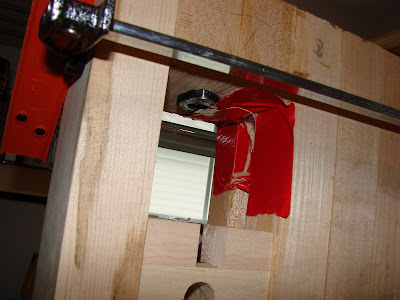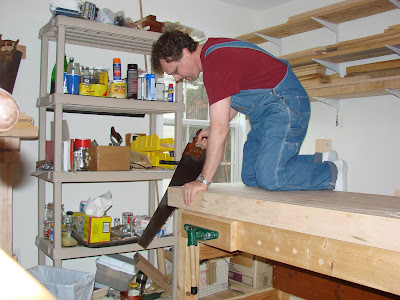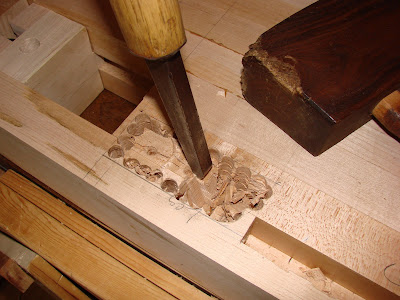I spread the joint a little bit with my beater glueing chisel (a modern, plastic-handled chisel I use for nasty jobs like cleaning up dried glue), drilled a few 3/32" holes into the joint from the back of the bench top, and proceeded to use the pinpoint gluers, which are long, thin metal tips attached to a little accordion-style glue bottle, to apply LOTS more glue. I squirted as much as I could into the drill holes, and then up at the end block for the wagon vise, I just came at it from every angle and was able to get the metal tips all the way into the joint and just flood it with glue.
Here's the split. The far right board on the edge is board 1, then you have board two and then three as you move into the top. The split was between board one and two below the wagon vise, and the between three and four at the end block for the wagon vise.


Arrrgh!
In the end I glued it up and put the clamps on and let it sit for about 12 hours. (yes, I did this first thing in the morning)

I was also very worried about glue squeeze out running into the wagon vise, so I taped over the gap with duct tape, which happens to be red, don't ask. This seems to have worked pretty good. There was squeeze out but the duct tape held it back enough that what little got through was easy enough to scrape off. My main worry was that I'd glue my vise chop into place!

Now that the crisis has been covered, let's go back and see what lead up to it. And you'll see how much work went into the top that morning, which made it all the more heartbreaking when the split happened. But I guess better now than when I went to clamp the first board in the wagon vise.
First thing I did that morning was to cut the ends off of the top. I used my c. 1917-1940 Disston D8 cut to 8tpi. It is a real trooper of a saw.

I had to get up on top of the bench to start the cut. I wanted to see the cut clearly. If I had more than one saw bench (yeah, yeah, I know) then I could have tried to haul the giant slab o' wood onto those, but this worked as well.

Starting the cut

Keeping to the line pretty well, at least from this angle.

You can see up where the cut started, just past the fourth board, and back at the corner where I cut a relieving cut so it didn't splinter out at the end, I actually cut a little out of perpendicular to the top. I'll be focusing on that when I break out my end grain planing operation.


I tried starting the cut from the floor when I did the other side and tried to keep it straighter up and down. I found the first four boards actually made this more difficult in the end. As you can see, I also flipped the bench to be able to saw this side right-handed. You can see the long slot for the sliding deadman down the front of the bench.

The next big operation was to cut the giant mortises into the top to fit the tenons on the ends of the legs. I tried all kinds of things, including a couple of big t-augers I have. I'll tell ya', that hard maple is more than a match for any of that stuff. I ended up, as I mentioned in my earlier post, drilling lots of smaller (1/2") holes around the perimeter of the mortise and then chopping out the rest of it. I did try on one mortise just boring out holes on just one end to give some relief and then chopping out the rest with my big mortise chisel. That ended up being a whole lot of work, which chips flying everywhere in the shop.

loved this little curl spit out by the bit.

Next time (ha!), I will make sure there is sufficient space between the end of the wagon vise and the mortise for the leg. As you can see the wall between the two is very thin and it blue out a little bit. I don't think it really hurts the integrity of the top, but I would have felt better with more wood between the two gaps.



These mortises are two-inches deep, two inches wide and five inches long. That's a lot of wood to take out.

This is when I finally figured out the best way to do this, and of course it was the last one. You can see the big chunk I was able to pop out. You can also see the drip of sweat on the wood. Between sawing and these mortises, I definitely got my workout for the day!

Once I got all the mortises cut, I went to fit the base to the top. I first put a bevel on the tops of the tenons to help ease them into the mortises.

I fiddled a bit and got the tenons in pretty tightly but couldn't quite make them go in all the way. This is when I flipped the bench onto the floor. (that was an adventure!)


And it was while I was trying to pound the tenons into place that the split happened. All of which I covered above. After all that work, you can see why when the top split I just put my tools down and walked away for the rest of the night. I had put in a good 8+ hours in the shop of hard work and I was tired, discouraged, hungry, sore and ready to stop.
While the split was drying (the next day), I glued up the boards for the leg vise chop. I also was reminded why I have a love/hate relationship with my Jorgenson clamps.

I planed out a little spring into the boards, put plenty of glue on and clamped them in. Or at least I thought I had. When I went back to take it out of the clamps I discovered that I hadn't actually tightened the middle clamp or the one on the end. They felt tight because I hadn't tilted the handles correctly and just tightened away until the handle wouldn't move any more. It wasn't tightened, it was just screwed all the way back while still in loose sliding mode. It's hard to describe, but if you have clamps like these you know what I'm talking about. So, I ended up with a nice little gap right down the middle of the boards where the spring was. AAAARRRGGGHH!!
So, after doing this again (I did have spares this time!) I got it right. One of the boards is a 1/16" out of true in the middle, it's a bit bent, but that I can deal with on a 7/4 thick board.

At that point I started to make my dinner. I felt I deserved a bit of a treat for all the hard work so I made myself a Bacon Explosion. (Look it up) It's basically a woven mat of bacon, stuffed with Italian sausage with cooked bacon in the middle. It's then slow cooked and eaten in slices. It's like smokey, spicy meatloaf, and quite good. I used a Caribbean rub instead of the BBQ sauce.





After my late, but very delicious, dinner, I went back up to the shop and very carefully fitted the tenons into the mortises. I never forced anything, and ended up cleaning out one of the mortises a little more, and taking some off of the tenons where it was rubbing, etc... In other words, all the stuff I should have done the first time. This time was a little easier because I had the top down on the floor sitting on four wooden blocks so I could get my fingers underneath it to lift it when I needed to. (Good idea!!) And in the end, Voila!


Here's the underside of the wagon vise. You can see the blow out of the thin wall between the mortise and the wagon vise on the left, and the squeeze out of the glue from the re-glue of the end block on the right. Not so pretty, but damn it, it works!

I couldn't resist getting out my #6 with a Hock iron and taking some cross passes on the bench. Sweet! It is going to flatten out nicely, and will be another source of a good workout.

AAAndrew

Andrew,
ReplyDeleteWhat can I say? I'm so glad you came by my site and left a comment or I may not have found your blog. I just spent a wonderful few hours reading through all of your posts. I'll be a frequent visitor from now on. I admire your tenacity. I just flushed up the ends of my Roubo last night and I discovered that none of my power tools were up to the task. The Circ saw is too wimpy and just smokes, and the router doesn't have the reach. So wouldn't you know I went with the Disston D23 and after dropping 5 lbs in the process, I cut one end. Now I think I need to look into this Bacon Explosion thing!
Shannon
I agree with Shannon. I've had a great time going through your whole blog - I think I'm almost current! But I'm added your feed to my feed reader so I'll be sure to keep up with new posts.
ReplyDeleteThis particular entry convinced me to just leave gaps in the boards on the top for the mortise, so I won't have to cut any! The tenons will just go through all the way to the top. But of course that has its own complications...
I'm really curious to see how that works out. If I were doing it, I'd make up two dummy "tenons" to use for glue-up spacing and just stick them in between the boards during glue up. Cover them with packing tape and they won't stick to the glue. I'd also leave the tenons on the legs just a bit too long and cut them flush. What you don't want is a divot in your bench top because the tenon was just a little too short. It's better to have to plane down the end grain then to have a hole in the top.
ReplyDeleteMy only concern with that would be when you go to flatten the top. For me, just having that (relatively) tiny section of differently-oriented grain of the wagon vise chop, slows down and slightly complicates the flattening process. If I had end grain to deal with as well, it would complicate it even more. You'd have to make sure that your blades in your plane were absolutely, positively sharp. I'd also use the alcohol in the end grain trick that The Schwartz talks about. It really does make it easier to plane end grain. But if your blade is at all dull, it becomes a real chore regardless of alcohol or not.
I've had fun recording this adventure. This really is meant to be a sort of shop notebook, so I'm writing this for myself, but I'm glad others can find it interesting or useful. (not always the same thing) :-)
I can't wait to get back into the shop. It's been a few weeks, but things should get back to normal soon.
AAAndrew